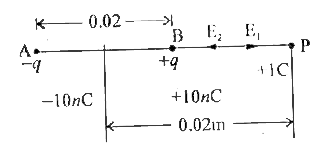Complete Solutions to NUMERICALS WITH SOLUTIONS of chapter ELECTRIC CHARGES AND FIELDS of Class 12 book with complete answers and questions
| Class 12 | PHYSICS |
| Chapter | ELECTRIC CHARGES AND FIELDS |
| SUBHASH PUBLICATION | NUMERICALS WITH SOLUTIONS |
| Number Of Questions | 21 |
| Academic Year | 2023-24 |
Two point charges `-2nC` and `+8nC` are separated in air by a distance of 0.10m.Find the position of the neutral point along the line joining the 2 point charges.
View SolutionTwo point charges `q_(1)=+4 mu c` and `q_(2)=+32 muc` are spearated in air at a distance of 0.12 m apart. Find the position of the neutral point along the line joining the 2 point charges.
View SolutionTwo point charges `+10muC` and `-15muC` are placed at the vertices A and B of a right angle `Delta^("le")` ABC, such that `AB=0.05m, BC=0.12m`. Calculate the result field intensity at the point C. If `+100muC` of charge is palced at C, then what force will be experienced by the point charge at C?
View SolutionFour point charges `+2nC,-3nC,+4nC,-5nC` are placed at the vertices A,B,C,D of a square ABCD of side 0.2 m respectively. Calculate the electric field intensity at a point of intersection of the diagonals.
View SolutionIn the given figure, what is the Flux enclosed by A and B?

View SolutionA system has two charges `q_(A)=2.5xx10^(-7)C` and `q_(B)=-2.5xx10^(-7)C` located at points `A-=(0,0,-15cm)` and `B=(0,0,+15cm) `respectively. What are the total charge and electric dipole moment of the system?
View SolutionTwo point charges `+10nC` and `-10nC` are separated by a distance of 0.02m. Calculate the electric field intensity at a point P on the axis of the dipole at 0.01 from `+10nC`.

View SolutionTwo point charges `+20nC` and `-20nC` are separated by a distance of 0.10m. Calculate the electric field intensity at a perpendicular distance 0.10 m from the centre of a dipole.
View SolutionTwo point charges `q_(A)=3muC` and `q_(B)=-3muC` are located 0.2 m apart in vacuum.
a. What is the electric field at the mid point O of the line AB joining the two charges?
b. If a negative test charge of magnitude `1.5xx10^(-9)C` is placed at this point, what is the force experienced by the test charge?

View SolutionA system has two charges `q_(A)=2.5xx10^(-7)C` and `q_(B)=-2.5xx10^(-7)C` located at points `A-=(0,0,-15cm)` and `B=(0,0,+15cm) `respectively. What are the total charge and electric dipole moment of the system?
View SolutionAn electric dipole with dipole moment `4xx10^(-9)` cm is aligned at `30^(@)` with the direction of a uniform electric field of magnitude `5xx10^(4)NC^(-1)`. Calculate the magnitude of the torque acting on the dipole.
View Solutiona. Two insulated charged copper spheres A and B have their centres separated by a distance o 0.5 m. What is the mutual force of electrostatic repulsion if the charge on each is `6.5xx10^(-7)C`? Assume that the radii of A and B are negligible compared to the distance fof separation.
b. What is the fore of repulsion if each sphere is charged double the above amount and the distance between them is halved?
View SolutionTwo insulated charged copper spheres A and B have their centres separated by a distance of 0.5 m. The charge on each spheres is `6.5xx10^(-7)C`. A third sphere c of identifical shape and size is brought in contanct with A and them brought in contact with B and finally removed. What is the new force between A and B?
View SolutionConsider a uniform electric field `vecE=3xx10^(3)hatiNC^(-1)`
a. Whate is the flux of this field through a square of 0.1 m on a side whose plane is parallel to the y-z plane?
b. What is the flux through the same square if the normal to its plane makes a 60 angle with x-axis?
View SolutionA uniformly charged conducting sphere of 2.4 m diameter has a surface charge density of `80xx10^(-6)cm^(-2)`
a. Find the charge on the sphere.
b. What is the total electric flux leaving the surface of the sphere?
View SolutionAn infinite line charge produces a fiedl of `9xx10^(4)NC^(-1)` at a distance of `2xx10^(-2)m`. Calculate the linear charge density.
View SolutionTwo large, thin metal plates are parallel and close to each other. On their inner faces, the plates have surface charge densities of opposite signs and magnitude `17.0xx10^(-22)Cm^(-2)`. What is the electric field
a. in the outer region of the first and the second plates?
b. between the plates?
View SolutionAn oil drop of 12 excess electrons is held stationary under a constant electric field of `2.55xx10^(4)NC^(-1)` in Millikan's oil drop experiment. The density of the oil is `1.26xx10^(3)kgm^(-3)`. Estimate the radius of the drop `(g=9.81ms^(-2),e=1.60xx10^(-19)C)`.
View SolutionIn a certain region of space, electric field is along the z-direction throughout. The magnitude of electric field is, however not constant but increases uniformly along the positive z-direction at the rate of `10^(5)NC^(-1)m^(-1)`. What are the force and torque experienced by a system having a total dipole moment equal to `10^(-7)` Cm in the negative z-direction?
View SolutionThe electric field components are`E_(x)=ax^(1//2),E_(y)=E_(z)=0` in which `a=800NC^(-1)m^(-1//2)`. Calculate a. the flux through the cube, and b. the charge within the cube. Assume that `a=0.1m`
View SolutionAn electric field is uniform and `E=200 hatiNC^(-1)` along `+x`s and `E=-200hatiNC^(-1)` along `-x` direction. A right circular cylinder of length 0.20 m and radius 0.05 m has its centre at the origin and its axis along the x-axis so that one face is `x=+0.10m` and the other `=x-0.10m`.
a. What is the net outward flux through each flat face?
b. What is the flux through the side of the cylinder?
c. What is the net outward flux throught the cylinder?
d. What is the net charge inside the cylinder?
View Solution
NUMERICALS WITH SOLUTIONS questions and complete solutions for chapter ELECTRIC CHARGES AND FIELDS of JEEVITH PUBLICATIONS PHYSICS (KANNADA ENGLISH) of Class 12